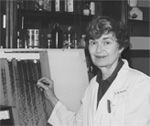Pioneering Women in Plant Pathology, Entomology Professor Virginia Ferris honored!
APSnet
Shop APS Press
The American Phytopathological Society
March 7, 2008
Below is an excerpt from the chapter about Virginia R. Ferris, or listen to the excerpt read by Cleo D'Arcy Audio.
Virginia R. Ferris
The Nematologist with a “Velvet Glove and Mailed Fist”
Robert McSorley
 Virginia Ferris earned a Ph.D. degree in plant pathology at Cornell University in 1954 studying potato late blight. After graduation, she shifted to work on the golden nematode, and nematology became her life’s work. Ferris juggled a family and career while generating her own grant funds for research that was conducted out of a basement laboratory during the time her children were young. Eventually, she was offered a part-time and then a full-time position at Purdue University. Her field studies resulted in major contributions to nematode ecology and systematics. She demonstrated the impact of crop rotation systems and soil type on the population dynamics of Pratylenchus spp. and other plant-parasitic nematodes in Midwestern cropping systems. Her later work in molecular systematics of the order Dorylaimida has clarified species and ecological relationships in this complicated group of organisms. Ferris is also distinguished as the first woman to be elected president of the Society of Nematologists. Virginia Ferris earned a Ph.D. degree in plant pathology at Cornell University in 1954 studying potato late blight. After graduation, she shifted to work on the golden nematode, and nematology became her life’s work. Ferris juggled a family and career while generating her own grant funds for research that was conducted out of a basement laboratory during the time her children were young. Eventually, she was offered a part-time and then a full-time position at Purdue University. Her field studies resulted in major contributions to nematode ecology and systematics. She demonstrated the impact of crop rotation systems and soil type on the population dynamics of Pratylenchus spp. and other plant-parasitic nematodes in Midwestern cropping systems. Her later work in molecular systematics of the order Dorylaimida has clarified species and ecological relationships in this complicated group of organisms. Ferris is also distinguished as the first woman to be elected president of the Society of Nematologists.
Pioneering Women in Plant Pathology is a biographical book on the early women scientists who led the way for others in the field of plant pathology. These untold stories about 27 fascinating women discuss their struggles and triumphs as early women in the science.
With contributions from 37 talented writers and more than 130 figures, we are given a true picture of the challenges these women faced on their way to important discoveries. The authors do a wonderful job presenting the scientific achievements of these women in the context of their time. We also get glimpses into the character of these women that show us how their personal attributes and talents helped them achieve great things.
This will be a great read for any of the women of plant pathology today and also the men who work beside them. As a historical book, it will be appropriate for introductory or graduate level plant pathology courses that teach about the early studies of plant disease. Women’s studies, agriculture, and science history classes could also use this as a supplementary text. Historians of science will also find this an interesting look into the past.
The 27 wonderful stories in the book are enhanced by historical documentation, samples of original research and published articles, reference material, and printed historical accounts. With APS turning 100 in 2008, it is fitting that this book arrived to help commemorate plant pathology’s important contributions during the Society’s centennial celebration year.
View entire story click here.
|